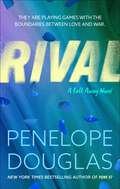- Table View
- List View
A Study in Silks (The Baskerville Affair #1)
by Emma Jane HollowayIn a Victorian era ruled by a council of ruthless steam barons, mechanical power is the real monarch and sorcery the demon enemy of the Empire. Nevertheless, the most coveted weapon is magic that can run machines - something Evelina has secretly mastered. But rather than making her fortune, her special talents could mean death or an eternity as a guest of Her Majesty's secret laboratories. What's a polite young lady to do but mind her manners and pray she's never found out?But then there's that murder. As Sherlock Holmes's niece, Evelina should be able to find the answers, but she has a lot to learn. And the first decision she has to make is whether to trust the handsome, clever rake who makes her breath come faster, or the dashing trick rider who would dare anything for her if she would only just ask.
A Study in Darkness (The Baskerville Affair #2)
by Emma Jane HollowayBefore Evelina's even unpacked her gowns for a country house party, an indiscretion puts her in the power of the ruthless Gold King, who recruits her as his spy. He knows her disreputable past and exiles her to the rank alleyways of Whitechapel with orders to unmask his foe.As danger mounts, Evelina struggles between hiding her illegal magic and succumbing to the darker aspects of her power. One path keeps her secure; the other keeps her alive. For rebellion is brewing, a sorcerer wants her soul, and no one can protect her in the hunting grounds of Jack the Ripper.
A Study in Ashes (The Baskerville Affair #3)
by Emma Jane HollowayEvelina's problems are part of a much larger war. The Baskerville affair is finally coming to light, and the rebels are making their move to wrest power from the barons and restore it to Queen Victoria. Missing heirs and nightmare hounds are the order of the day - or at least that's what Dr. Watson is telling the press.But their plans are doomed unless Evelina escapes to unite her magic with the rebels' machines - and even then her powers aren't what they used to be. A sorcerer has awakened a dark hunger in Evelina's soul, and only he can keep her from endangering them all. The only problem is . . . he's dead.
Viper Game (Ghostwalker Novel #11)
by Christine FeehanHailed as "the queen of paranormal romance" by J.R. Ward, #1 New York Times bestselling author Christine Feehan continues to amaze readers with her phenomenal novels. Now, from the author of the Dark Carpathian series, comes the newest in Christine Feehan's explosive GhostWalker series . . . GhostWalker Wyatt Fontenot knows the price he paid for the secret military experiments that gave him his special catlike abilities. After all, he left his bayou home a healer and came back a killer. While Wyatt and his GhostWalker brother Gator may have known exactly the sort of game they were getting into, Wyatt never anticipated where it would lead - or to whom.The swamps hold many mysteries, but few are as sinuously seductive as Le Poivre de Cayenne. The woman the locals call Pepper is every bit as enigmatic as the three little girls she's desperately trying to protect. From what, Wyatt is soon to discover. Right now Pepper needs a man like Wyatt. Passionately. But her secrets are about to take them both deeper into the bayou than either imagined -- where desire is the deadliest poison of all.
Cat's Lair (Leopard People #6)
by Christine FeehanPrepare to enter the lair of the Leopard People . . . The #1 New York Times bestselling author of Leopard's Prey returns to the feral underworld of her astonishing Leopard novels in an arousing new romance of forbidden animal instincts... Cat Benoit has finally escaped the past - and the man who was the source of her nightmares. She's off the grid, underground but watchful, and creating a new life for herself in Texas, far from the torrid dangers of her native New Orleans. She's safe. He'll never find her this time. Cat has to believe that. It's the only thing keeping her sane. Yet she can't escape the attention of Ridley Cromer, the instructor at the martial arts dojo where Cat takes lessons. She arouses the animal in Ridley-and something feral comes to life when their body heat rises. Cat is in no position to let her guard down with anyone, especially someone who could be endangered by her past. But Ridley has secrets of his own-secrets only Cat would understand. If she dares to trust him. 'The queen of paranormal romance! The one who started it all! I love everything she does' - J.R. Ward '[A] dark and seductive paranormal romance series.' - Heroes and Heartbreakers
Earth Bound (Sea Haven #4)
by Christine Feehan#1 New York Times bestselling author Christine Feehan returns to the mysterious coastal town of Sea Haven where six sisters of the heart are bound by the elements, and one is stalked by an inescapable past...After escaping from a cult, Lexi found refuge with her sisters on the farm that more than sustained her body-it nurtured her soul as well. But she never forgot the terror she left behind or the always present fear that the cult would find her again, and claim her. Then her nightmare came true.Lexi was discovered and threatened-only to be suddenly saved by a stranger. He is Gavriil Prakenskii, and he's awestruck by the woman he's rescued. She is destined for him. He can feel it in his soul. But how can Lexi find happiness with a man steeped in secrets and shadows, one intimately acquainted with violence, and whose very love could be the death of them?
Dark Ghost (Dark Carpathian #28)
by Christine FeehanHe wasn't civilized or tame. He had his own code and he lived by it.Monk. Bounty hunter. Vampire slayer. Andre Boroi has spent centuries battling the undead, holding out against the dark with honor. But now, gravely wounded by master vampire Costin Popescu, Andre will be easy to track - his spilled blood marking the killing trail for Popescu and his hungry band of underlings. Andre's only chance is to disappear into the gray mist of the Carpathians. To wait. To hope.She had a healing touch and a scent that was his lifeblood.In the mountains in search of a precious crystal, geologist Teagan Joanes suddenly finds herself hunted by those she once trusted. Then she comes across the warrior- wounded, wanting and irresistible. Andre has been craving her for an eternity: his lifemate. Her warmth envelops him. Her scent pulsates. And with every beat of her heart, Teagan surrenders to a passion she can't possibly comprehend.Now they are bound by destiny, but is it enough to keep them safe from a stalking, relentless darkness that threatens to swallow them alive?
Dark Promises (Dark Carpathian #29)
by Christine FeehanLovers challenge destiny and risk their lives in the new Carpathian novel by the #1 New York Times bestselling 'queen of paranormal romance.' (J.R. Ward)Gabrielle has had enough of battles, of wars, of seeing Gary Jansen, the man she loves nearly lose his life when it isn't even his fight. Once he was a gentle and very human researcher. Now he's a fearless and lethal Carpathian warrior with the blood of an ancient lineage coursing through his veins-a man Gabrielle still needs and desires and dreams of with every breath she takes. All she wants is a life far away from the Carpathian mountains, far from vampires and the shadows cast by the crumbling monastery that hides so many terrible secrets. But Gabrielle soon learns that promises made in the dark can pierce the heart like a dagger.And she isn't the only one in search of answers in the corners of the unknown.... Trixie Joanes has come to the Carpathian mountains in search of her wayward granddaughter, fearing that she has been lured there by something unspeakable. Instead, Trixie has stumbled into the path of a desperate man and a woman in love and on the run. And they're all fated for the lair of a mysterious ancient with revenge in his soul and the undying power to make bad dreams come true.'After Bram Stoker, Anne Rice and Joss Whedon, Christine Feehan is the person most credited with popularizing the neck gripper.'Time'Feehan has a knack for bringing vampiric Carpathians to vivid, virile life in her Dark Carpathian novels.'Publishers Weekly
You Can Be Younger: Use the power of your mind to look and feel 10 years younger in 10 simple steps
by Marisa PeerThe way we look and feel has very little to do with our chronological age: positive thinking and changing your belief system are the most important factors in staying young.In this exciting new book, leading therapist Marisa Peer explains how you can arrest the ageing process by harnessing the power of your subconscious mind. By changing your thinking, you can change your body and become physically and mentally at least ten years younger.You Can Be Younger contains a ten-step programme to teach you how to:Retrain your mind so you can stay young and vibrantUse Marisa's cell regeneration therapy to counteract the ageing processBoost energy and visibly improve your skin's appearanceMarisa Peer shares the secrets her celebrity clients know so that you too can look and feel more youthful.
You Can Be Younger: Use the power of your mind to look and feel 10 years younger in 10 simple steps
by Marisa PeerThe way we look and feel has very little to do with our chronological age: positive thinking and changing your belief system are the most important factors in staying young.In this exciting new book, leading therapist Marisa Peer explains how you can arrest the ageing process by harnessing the power of your subconscious mind. By changing your thinking, you can change your body and become physically and mentally at least ten years younger.You Can Be Younger contains a ten-step programme to teach you how to:Retrain your mind so you can stay young and vibrantUse Marisa's cell regeneration therapy to counteract the ageing processBoost energy and visibly improve your skin's appearanceMarisa Peer shares the secrets her celebrity clients know so that you too can look and feel more youthful.
Why Can't I Meditate?: how to get your mindfulness practice on track
by Nigel WellingsThere are now thousands of students completing Mindfulness-Based Stress Reduction, Mindfulness-Based Cognitive Therapy and other mindfulness programmes around the world. However, on completion many will struggle to continue or will stop, with the intention of starting again in the future. Why Can't I Meditate? addresses this problem. It combines accounts by new meditators of their struggles, and successes, with insights from a wide variety of the most accomplished teachers, representing every school of mindfulness teaching. It identifies, investigates and offers many practical solutions to get our mindfulness unstuck and firmly establish a regular practice. This is a book for anyone who has sat on their meditation seat or cushion and wondered whether they should go on. Contributors include: Stephen Batchelor, Rebecca Crane, Christina Feldman, Geshe Tashi Tsering, Choji Lama Rabsang, Willem Kuyken, Tsoknyi Rinpoche, Franklin Sills, Philippa Vick and Martin Wells.
Bully (Fall Away Ser. #1)
by Penelope DouglasMy name is Tate. He doesn't call me that, though. He would never refer to me by a friendly nickname. No, he'll barely even speak to me. But he still won't leave me alone.We were best friends once. Then he turned on me and made it his mission to ruin my life. I've been humiliated, shut out, and gossiped about all through high school. His pranks and rumors got worse as time wore on, and I made myself sick trying to stay out of his way. I even went to France for a year, just to avoid him.But I'm done hiding from him now, and there's no way in hell I'll allow him to ruin another year. He might not have changed, but I have. It's time to fight back.For fans of Abbi Glines and Colleen Hoover comes the next big name in New Adult romancePraise for Bully:'Penelope creates incredible tension between her characters in this best friends to enemies to lovers romance. It touches on the trauma of high school relationships, first loves, and broken hearts, and most importantly, how to be with someone without losing yourself' Helena Hunting, author of The Good Luck Charm'A wonderfully addictive read that kept my heart racing from start to finish. I could not put it down!' Aesta's Book Blog'A heated and passionate novel, full of feeling and intensity that will appeal to the reader seeking an emotional rush' IndieReader.com
Until You (Fall Away Ser. #2)
by Penelope DouglasHave you ever been so angry that hitting things felt good? Ever felt numb to all emotions?The past few years have been like that for me. Traveling between fury and indifference with no stops in between. Some people hate me for it, while others are scared of me. But none of them can hurt me, because I don't care about anything or anyone. Except Tatum. I love her so much that I hate her. I hate that I can't let her go. We used to be friends, but I found out that I couldn't trust her or anyone else. So I hurt her. I pushed her away. But I still need her. She centers me. Engaging, challenging, bullying her - it's the last part of me that feels anything human. But then she left for a year and came back a different girl. Now, when I push, she pushes back.For everyone who loved Bully . . . This is Jared's story. Praise for Penelope Douglas'I was really craving a book that would make me stop everything I was supposed to be doing and devour every word... and that's exactly what Bully did!' - Smitten Book Blog'A unique twist on the bad boy meets good girl tale. I could not put it down!' - Aestas Book Blog'She did something seasoned writers haven't been able to do-take a hero who was a complete ass and make me fall in love with him' - Scandalicious Book Reviews
Rival (Fall Away Ser. #3)
by Penelope DouglasMadoc and Fallon. Two estranged teenagers playing games that push the boundaries between love and war . . . She's back.For the three years she's been away at boarding school, there was no word from her. Back when we lived in the same house, she used to cut me down during the day and then leave her door open for me at night.I was stupid then, but now I'm ready to beat her at her own game . . .I'm back.Three years and I can tell he still wants me, even if he acts like he's better than me.But I won't be scared away. Or pushed down. I'll call his bluff and fight back. That's what he wants, right? As long as I keep my guard up, he'll never know how much he affects me . . . Praise for the Fall Away Series'I read this book in one sitting. Rival was as gripping as it was sexy!' #1 New York Times bestselling author Colleen Hoover'Full of feeling and intensity that will appeal to the reader seeking an emotional rush' IndieReader'I was really craving a book that would make me stop everything I was supposed to be doing and devour every word . . . and that's exactly what Bully did!' Smitten Book Blog'A unique twist on the bad boy meets good girl tale. I could not put it down!' Aestas Book Blog'She did something seasoned writers haven't been able to do - take a hero who was a complete ass and make me fall in love with him' Scandalicious Book Reviews
Falling Away (Fall Away Ser. #4)
by Penelope DouglasJaxon is the guy she's supposed to avoid . . . K. C. Carter has always followed the rules - until this year, when a mistake leaves her the talk of her college campus and her carefully arranged life comes crashing to a halt. Now she's stuck in her small hometown for the summer to complete her court-ordered community service, and to make matters worse, trouble is living right next door.K.C. is the girl he won't let get away . . . Jaxon Trent is the worst kind of temptation and exactly what K.C. was supposed to stay away from in high school. But he never forgot her. She was the one girl who wouldn't give him the time of day and the only one to ever say no. Fate has brought K.C. back into his life - except what he thought was a great twist of luck turns out to be too close for comfort. As they grow closer, he discovers that convincing K.C. to get out from her mother's shadow is hard, but revealing the darkest parts of his soul is nearly impossible.See the trailer!! https://www.youtube.com/watch?v=NrljC...'I read this book in one sitting. Rival was as gripping as it was sexy!' - Colleen Hoover Quote from Penelope Douglas:Bully was my love. Until You was my responsibility.Rival was my pleasure.But Falling Away was my destiny. Every whisper, every breath, every kiss, and every word came from my gut. This is the book I'm most proud of.
Branded: If Only... / A Deal Before The Altar / Falling For Her Captor / Here Comes The Bridesmaid / The Surgeon's Christmas Wish / All's Fair In Lust And War / The Pirate Hunter / Dressed To Thrill (The Cavanaugh Brothers #1)
by Laura WrightIn the small town of River Black, Texas, sits the Triple C - a working cattle ranch that sustains the town. But it also holds painful memories and shocking secrets for the Cavanaugh brothers . . .When the Cavanaugh brothers return home for their father's funeral, they discover unexpected evidence of the old man's surprising double life - a son named Blue, who wants the Triple C Ranch as much as they do. The eldest son, Deacon, a wealthy businessman who couldn't wait to leave the ranch and move on with his life, is looking to use his powerful connections to stop Blue at any cost. He never expected the ranch's forewoman, Mackenzie Byrd, to get in his way.Mac knows Deacon means to destroy the ranch and therefore destroy her livelihood. But as the two battle for control, their attraction builds. Now Deacon is faced with the choice of a lifetime: Take down the Triple C to feed his need for revenge, or embrace the love of the one person who has broken down every barrier to his heart.Praise for Branded:'A sexy hero, a sassy heroine, and a compelling storyline, BRANDED is all that and more - I loved it!' -Lorelei James, New York Times bestselling author 'Saddle up for a sexy, intensely emotional ride with cowboys that put the wild in wild west. Laura Wright never disappoints!' - Alexandra Ivy, New York Times bestselling author 'Secrets, sins, and spurs - Laura Wright's Cavanaugh brothers will brand your heart!' - Skye Jordan, New York Times bestselling author 'Saddle up for a sexy and thrilling ride! Laura Wright's cowboys are sinfully hot' - Elisabeth Naughton, New York Times bestselling author 'Deadly secrets, explosive sex, four brothers in a fight over a sprawling Texas ranch . . . Ms. Wright has penned a real page-turner' - Kaki Warner, bestselling author
Broken: Pathways To Wellness (The Cavanaugh Brothers #2)
by Laura WrightThe Cavanaugh brothers left behind River Black, Texas, long ago. But after their father dies, bequeathing them the Triple C, a cattle ranch that sustains their small town, they return - and confront the painful memories of their childhood home . . .For years, James Cavanaugh has travelled the world as a horse whisperer, but even the millions he's earned hasn't healed the pain he hides behind his stoic exterior. Forced to tackle old demons at the ranch, James throws himself into work to avoid his true feelings. Until he meets a woman who shakes the foundations of his well-built walls . . . Sheridan O'Neil's quiet confidence has served her well, except when it comes to romance. Tired of rejection, she's ready to swear off men. But after being rescued from a horse stampede by the most beautiful cowboy she's ever met, her resolve wavers. Only, as Sheridan uncovers James's belief that no woman is safe with him, she wonders if such a wounded man could ever give in to love, or if some hearts are too broken to be healed . . .For fans of Joan Johnston, Pat Thayer, MJ Summers and smokin' hot cowboys, this is sheer reading pleasurePraise for Laura Wright'A sexy hero, a sassy heroine, and a compelling storyline, BRANDED is all that and more - I loved it!' -Lorelei James, New York Times bestselling author 'Saddle up for a sexy, intensely emotional ride with cowboys that put the wild in wild west. Laura Wright never disappoints!' - Alexandra Ivy, New York Times bestselling author 'Secrets, sins, and spurs - Laura Wright's Cavanaugh brothers will brand your heart!' - Skye Jordan, New York Times bestselling author 'Saddle up for a sexy and thrilling ride! Laura Wright's cowboys are sinfully hot' - Elisabeth Naughton, New York Times bestselling author 'Deadly secrets, explosive sex, four brothers in a fight over a sprawling Texas ranch . . . Ms. Wright has penned a real page-turner' - Kaki Warner, bestselling author
Brash (The Cavanaugh Brothers #3)
by Laura WrightNo matter how many fights UFC champion Cole Cavanaugh wins, he can't rid himself of the guilt of not having saved his twin sister's life. Now, not only is he facing his arch enemy in the ring, he's fighting to uncover the truth about Cass's death. But will winning both fights truly give him the retribution and absolution he seeks? Or does he need the healing power of love to finally move on with his life?The mystery surrounding Cass's murder also haunts veterinarian Grace Hunter. Many believe that her father might hold the key to the truth. Unfortunately the ex-Sheriff's deteriorating mental state makes it impossible to separate fact from fiction. As Cole persuades Grace to help him unlock the elusive clues, her defenses weaken. She finds the Stetson-wearing fighter irresistible. But while the truth could free Cole's heart, it could very well end up shattering hers.
Bonded (The Cavanaugh Brothers #4)
by Laura WrightThe Triple C Ranch is full of cowboys, romance and danger... Ranch hand Blue Perez's once simple life is spinning out of control. He's discovered he has three half-brothers, and they're not ready to accept his claim on the ranch. Also, Blue's girlfriend may have betrayed him in the worst way possible. And after one evening of drowning his sorrows at the bar, there's someone he can't get out of his mind, a woman who says she's carrying his child.Following a night of breathtaking passion in the arms of a man who now rules her dreams, waitress Emily Shiver is contemplating her next step. Blue is determined to be a part of her life, yet she would rather raise the baby on her own. But when she becomes the target of someone's dark obsession, Emily must let Blue in - to both her heart and her future.
The Boleyn Bride
by Emily PurdySixteen, of noble birth and stunningly beautiful, Elizabeth Howard envisions a glorious life for herself as lady-in-waiting to the future queen, Catherine of Aragon. But when she is forced to marry Thomas Boleyn, a wealthy commoner, Elizabeth is left to stagnate in the countryside while her detested husband pursues his ambitions. There, she raises golden girl Mary, moody George, and ugly duckling Anne - while staving off boredom with a string of admirers. Until Henry VIII takes the throne . . . When Thomas finally brings his highborn wife to London, Elizabeth indulges in lavish diversions and dalliances - and catches the lusty king's eye. But those who enjoy Henry's fickle favor must also guard against his wrath. For while her husband's machinations bring Elizabeth and her children to the pinnacle of power, the distance to the scaffold is but a short one - and the Boleyn family's fortune may be turning...Praise for Emily Purdy:'[Purdy] succeeds in rendering Elizabeth both unforgettable and undeniably real.' Historical Novel Society 'It has been some time since I've been so captivated by a Tudor based historical novel. I have to admit to being somewhat burned out by the over saturation of the Tudors . . . however, The Boleyn Bride has renewed my interest. I highly recommend it.' The True Book Addict'Classic story of a woman scorned, who is after revenge of the most bloody kind.' Closer Magazine'A rollercoaster tale which gives a new and fascinating perspective on three young women who became hostages to fortune in a perilous and turbulent age.' Lancashire Evening Post'Nicely written, and full of lust, greed and intrigue, this is a book sure to earn Emily Purdy many new fans.'Bookwormink.co.uk
Ember (Darkest London #1)
by Kristen CallihanAfter a fire consumes the Ellis family fortune, the beautiful and resourceful Miranda finds herself facedwith an impossible dilemma: enter a life of petty crime or watch her family succumb to poverty. But once herfiancée learns of her descent into danger - and of the strange, new powers she's discovered - saving herfamily may come at the high price of her heart. When Lord Benjamin Archer's one chance for redemption is destroyed by his enemy, Hector Ellis, he vows to take what Ellis values most - his daughter Miranda. Forced to hide his face behind masks, Archer travels the world hoping to escape the curse that plagues him so that he can finally claim his prize. But once Archer returns home to London, will it be revenge he seeks? Or will the flame-haired beauty ignite new, undeniable desires?For fans of Diana Gabaldon, Cassandra Clare, Amanda Quick and Gail CarrigerPraise for Kristen Callihan:'Callihan has a great talent for sexual tension and jaw-dropping plots that weave together brilliantly in the end.' Diana Gabaldon 'Evocative and deeply romantic, fascinating from the very first page.' Nalini Singh"A sizzling paranormal with dark history and explosive magic! Callihan is an impressive new talent." Larissa Ione
Firelight (Darkest London #2)
by Kristen CallihanFor fans of Diana Gabaldon, Amanda Quick and Nalini Singh comes the Darkest London series. In Victorian London, magic lurks in every shadowy corner . . .'Callihan has a great talent for sexual tension and jaw-dropping plots' - Diana Gabaldon'A sizzling paranormal with dark history and explosive magic! Callihan is an impressive new talent' - Larissa IoneLondon, 1881Once the flames are ignited . . . Miranda Ellis is a woman tormented. Plagued since birth by a strange and powerful gift, she has spent her entire life struggling to control her exceptional abilities. Yet one innocent but irreversible mistake has left her family's fortune decimated and forced her to wed London's most nefarious nobleman.They will burn for eternity . . . Lord Benjamin Archer is no ordinary man. Doomed to hide his disfigured face behind masks, Archer knows it's selfish to take Miranda as his bride. Yet he can't help being drawn to the flame-haired beauty whose touch sparks a passion he hasn't felt in a lifetime. When Archer is accused of a series of gruesome murders, he gives in to the beastly nature he has fought so hard to hide from the world. But the curse that haunts him cannot be denied. Now, to save his soul, Miranda will enter a world of dark magic and darker intrigue. For only she can see the man hiding behind the mask.'Evocative and deeply romantic, Firelight was fascinating from the very first page' - Nalini Singh'Callihan has a great talent for sexual tension and jaw-dropping plots' - Diana Gabaldon'A sizzling paranormal with dark history and explosive magic! Callihan is an impressive new talent' - Larissa Ione'Debut author Callihan pens a compelling Victorian paranormal with heart and soul' - Publishers Weekly'A taut tale filled with sexual tension. This is one of the finest debuts of the season' - RT Book ReviewsKristen Callihan is RITA nominated and the bestselling author of The Hook Up
Moonglow (Darkest London #3)
by Kristen CallihanOnce the seeds of desire are sown . . . Finally free of her suffocating marriage, widow Daisy Ellis Craigmore is ready to embrace the pleasures of life that have long been denied her. Yet her newfound freedom is short lived. A string of unexplained murders has brought danger to Daisy's door, forcing her to turn to the most unlikely of saviors . . . Their growing passion knows no bounds . . . Ian Ranulf, the Marquis of Northrup, has spent lifetimes hiding his primal nature from London society. But now a vicious killer threatens to expose his secrets. Ian must step out of the shadows and protect the beautiful, fearless Daisy, who awakens in him desires he thought long dead. As their quest to unmask the villain draws them closer together, Daisy has no choice but to reveal her own startling secret, and Ian must face the undeniable truth: Losing his heart to Daisy may be the only way to save his soul.For fans of Cassandra Clare, Gail Carriger and Amanda Quick - this is a dark, paranormal romance you won't want to miss. 'Evocative and deeply romantic' - Nalini Singh'A sizzling paranormal with dark history and explosive magic! Calligan is an impressive new talent' - Larissa Ione
Winterblaze (Darkest London #4)
by Kristen CallihanOnce blissfully in love . . . Poppy Lane is keeping secrets. Her powerful gift has earned her membership in the Society for the Suppression of Supernaturals, but she must keep both her ability and her alliance with the Society from her husband, Winston. Yet when Winston is brutally attacked by a werewolf, Poppy's secrets are revealed, leaving Winston's trust in her as broken as his body. Now Poppy will do anything to win back his affections . . . Their relationship is now put to the ultimate test.Winston Lane soon regains his physical strength but his face and heart still bear the scars of the vicious attack. Drawn into the darkest depths of London, Winston must fight an evil demon that wants to take away the last hope of reconciliation with his wife. As a former police inspector, Winston has intelligence and logic on his side. But it will take the strength of Poppy's love for him to defeat the forces that threaten to tear them apart.
Shadowdance (Darkest London Ser. #Bk. 4)
by Kristen CallihanThe fourth book in Kristen Callihan’s Darkest London series set in Victorian London will appeal to fans of New York Times bestselling authors Amanda Quick, Gail Carriger, and Hannah Howell.























